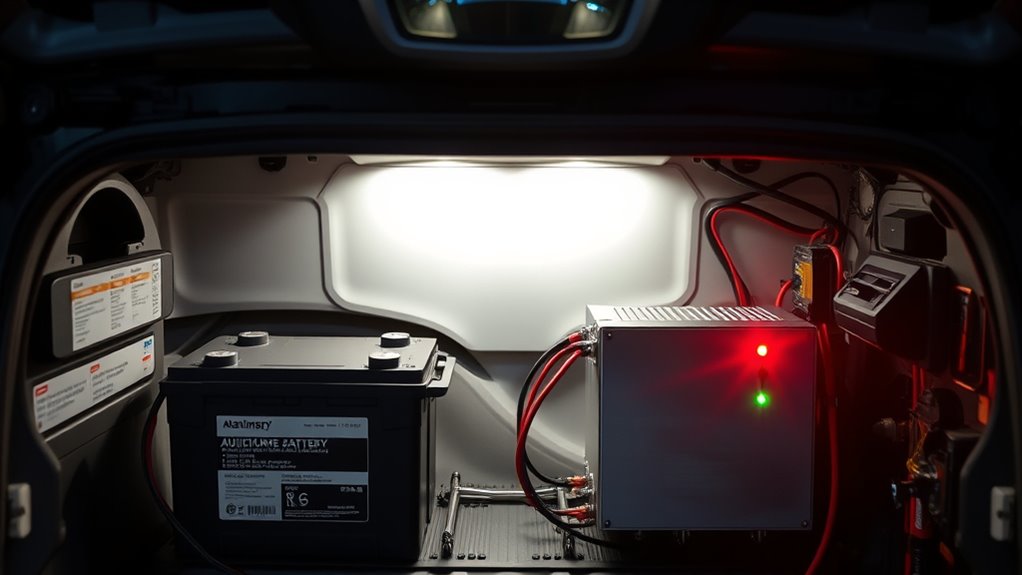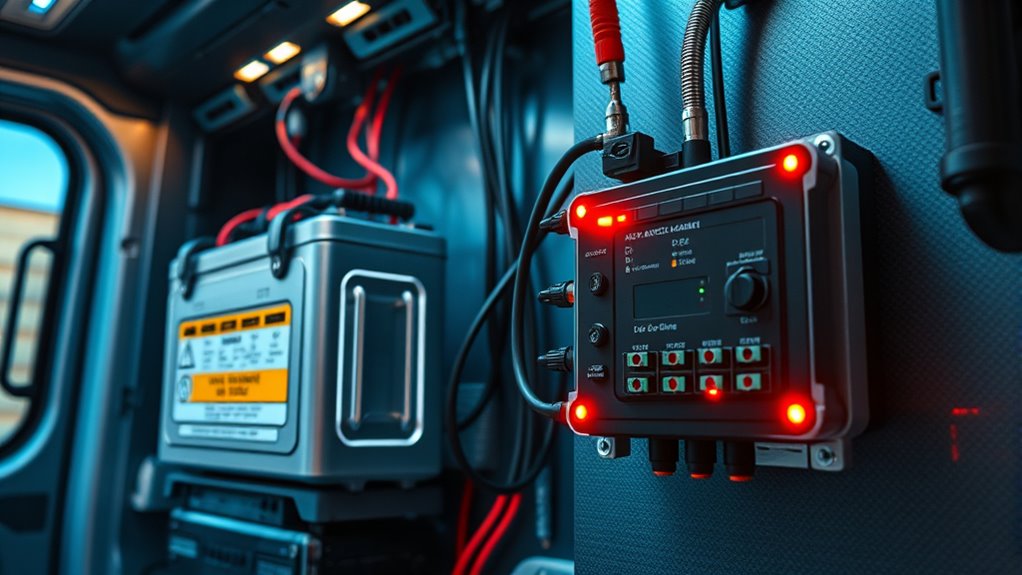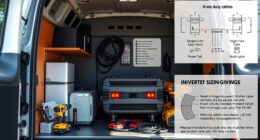Auxiliary batteries in transit vehicles provide backup power to essential systems like lighting, safety features, and electronics, especially when the main battery is low or off. DC‑DC chargers ensure these batteries stay charged efficiently by converting voltage and managing power flow, which extends battery life and improves safety. Innovations like AGM and lithium-ion tech enhance durability and performance. Keep exploring to discover how these systems work together to keep your transit reliable and safe.
Key Takeaways
- Auxiliary batteries provide backup power for critical vehicle systems and support start-stop and autonomous functions in transit vehicles.
- DC-DC chargers regulate voltage and current between main and auxiliary batteries, ensuring efficient, safe charging and extending battery life.
- Safety standards like UN 38.3 and UL 1487 ensure auxiliary batteries and DC-DC systems meet transport and thermal safety requirements.
- Advanced management systems with MPPT solar regulation and AI optimize battery charging, improve durability, and reduce maintenance costs.
- Proper integration of auxiliary batteries and DC-DC chargers enhances vehicle reliability, safety, and energy efficiency during transit operations.
Types of Auxiliary Batteries Used in Transit Vehicles

Transit vehicles use various auxiliary batteries to support their electrical systems, each with distinct advantages suited to different applications. Lead-acid batteries, mainly VRLA and flooded types, are common in traditional transit vehicles. Flooded batteries need regular maintenance and fluid level checks, while VRLA variants are sealed and require less upkeep. These batteries are heavier and larger, which impacts vehicle weight. AGM batteries, a sealed lead-acid subtype, are popular in modern transit for their spill-proof, vibration-resistant design, supporting start-stop systems and high electrical loads. Deep cycle batteries are built for repeated deep discharges, powering onboard electronics like lighting and fridges. Lithium-ion batteries, the lightest and most energy-dense, offer minimal self-discharge, longer lifespan, and are ideal for weight-sensitive and high-performance transit applications. Additionally, battery lifespan varies significantly depending on usage and maintenance practices, affecting overall system reliability. Proper maintenance practices also play a critical role in extending battery life and ensuring dependable performance. Considering alternative investment options like Gold IRAs can provide added financial security for transit agencies seeking diversification.
Key Performance Metrics for Transit Auxiliary Batteries

When evaluating transit auxiliary batteries, you need to consider their capacity and power ratings to ensure they meet your operational demands. Safety and durability metrics are equally critical, as they help prevent failures and extend battery life under demanding conditions. Understanding these key performance indicators enables you to optimize battery selection and maintain reliable transit service. Additionally, advancements in AI technology are beginning to influence battery management systems, leading to smarter and more efficient operation. Monitoring battery health is essential for predictive maintenance and avoiding unexpected outages, which can be further supported by real-time data analytics to anticipate potential issues before they occur.
Capacity and Power Ratings
Capacity and power ratings are critical metrics that determine how effectively auxiliary batteries support electric transit vehicles. They influence runtime, recharging speed, and system efficiency. Here’s what you need to know:
- Typical auxiliary battery capacities range from 16 kWh to 32 kWh, supporting vehicle systems without draining main batteries. These capacities are chosen based on the specific energy needs of the vehicle’s ancillary systems.
- Main batteries, like those in Ford E-Transits, can have capacities from 68 kWh in early models to 89 kWh in newer ones.
- Charging power varies from 120 amps (1,500 watts) up to 200 amps, impacting recharge times. Charging infrastructure advancements have made higher amperage chargers more accessible.
- Fast charging rates for main batteries have increased from 115 kW to around 180 kW, enabling rapid recharges in under 30 minutes. Advancements in fast charging technology now allow for quicker turnaround times and increased operational efficiency in transit systems.
These ratings confirm the batteries meet performance, safety, and longevity standards essential for transit applications.
Safety and Durability Metrics
Ensuring safety and durability in auxiliary batteries requires rigorous attention to multiple key performance metrics. Thermal safety is critical; lithium NCA batteries can sustain fires through thermal runaway if not properly managed. Effective thermal management materials and containment systems help prevent fire spread, especially during crashes. Additionally, implementing thermal sensors and fire-resistant casings can significantly enhance overall safety. Incorporating advanced thermal management systems is essential for maintaining optimal operating temperatures and preventing overheating. Electrical safety relies on active monitoring systems that alert operators before voltage reaches unsafe levels, with fail-safes to prevent damage. Durability depends on environmental resilience—batteries must withstand temperature extremes, vibration, humidity, and shocks. Certification standards like SAE J2464, UN/DOT 38.3, and ECE R100 ensure compliance. Crashworthy enclosures and rigorous testing guarantee mechanical integrity. Incorporating advanced safety features like thermal sensors and fire-resistant casings enhances overall safety. Additionally, ongoing performance testing helps identify potential vulnerabilities before deployment. Use the table below to compare key safety and durability metrics:
| Metric | Focus Area |
|---|---|
| Thermal Safety | Fire prevention |
| Voltage Management | Electrical safety |
| Environmental Durability | Operating in transit conditions |
| Certification Compliance | Regulatory standards |
| Mechanical Integrity | Crashworthiness |
The Role of Auxiliary Batteries in Vehicle Electrical Systems

Auxiliary batteries serve as a reliable power backup, ensuring your vehicle’s essential systems stay operational even when the main battery is off or low. They work seamlessly with the primary system, supporting everything from lighting to safety features without draining the main battery. Understanding how they integrate helps you appreciate their role in maintaining vehicle stability and safety. Additionally, incorporating electric power generation options such as bike generators can further enhance energy resilience in various applications. For example, some advanced systems may include energy storage solutions to optimize power use and extend functionality. This integration can also facilitate sound healing science practices by providing stable power sources for specialized equipment.
Power Backup Functionality
In vehicle electrical systems, auxiliary batteries serve a crucial role by providing backup power when the main battery is unable to supply enough energy. They guarantee essential systems stay operational during engine off periods or battery stress. Here’s how they support power backup:
- Keep critical 12V systems like lighting, infotainment, and control units running during engine shutoff.
- Power advanced features such as Start/Stop systems and ADAS without interruption.
- Act as a safety backup, preventing voltage drops that could disrupt sensitive subsystems during engine starts.
- Share electrical loads, reducing strain on the main battery and extending its lifespan.
- Monitor the voltage levels of both batteries to ensure reliable power delivery and prevent unexpected shutdowns. Properly managing these batteries is essential for maintaining overall vehicle electrical system reliability. Regular testing and maintenance of auxiliary batteries help ensure their long-term performance and dependability. Utilizing DC-DC chargers can optimize the charging process, ensuring both batteries are maintained at proper voltage levels for reliable operation.
Integration With Main System
To effectively support your vehicle’s electrical system, auxiliary batteries are integrated with the main power source through sophisticated charging and management systems. These systems include alternators, DC-DC chargers, and battery management units that monitor each battery’s state of charge (SOC). During operation, contact switches or isolators open and close to direct charging current to the auxiliary battery when needed, preventing overcharge and guaranteeing ideal performance. This setup reduces the load on the main alternator, improving fuel efficiency and lowering emissions. In hybrids and EVs, dedicated DC-DC converters supply stable 12V power to auxiliary batteries, which support essential systems like lighting, infotainment, and safety electronics. Proper integration ensures continuous power, protects battery health, and maintains system reliability during engine start, stop, and idle conditions. Using battery management units helps optimize overall system performance and longevity. Additionally, the use of trustworthy brands can enhance reliability and ensure quality in auxiliary battery systems. Incorporating advanced charging technology further ensures that auxiliary batteries are charged efficiently and safely under various operating conditions.
How DC-DC Chargers Enhance Auxiliary Battery Functionality

DC-DC chargers substantially improve auxiliary battery performance by optimizing the charging process and protecting system components. They enable multi-stage charging profiles that boost battery longevity and capacity. They also incorporate MPPT solar regulation, prioritizing solar input to reduce alternator load. Compatibility with various battery chemistries allows tailored charging, extending battery life. The SoftStart feature manages high current demands during initial charge, preventing damage. Additionally, these chargers limit current draw to about 50% of the alternator’s output, maximizing efficiency while safeguarding the system. Redarc BCDC chargers support a wide range of battery types and sizes, ensuring versatile application across different setups. Here’s what they do: 1. Optimize voltage and current for different battery types. 2. Manage voltage differences between vehicle systems. 3. Increase charging speed with multiple units. 4. Maximize solar power while minimizing alternator wear. Incorporating preppy dog names can also add a touch of personality to your system’s setup, reflecting style and sophistication. These chargers utilize advanced AI-driven algorithms to continuously adapt charging strategies for optimal performance.
Safety Standards and Compliance for Transit Battery Systems

You need to guarantee your transit battery systems meet strict safety standards to prevent hazards during transport and operation. This involves obtaining proper certifications like UN 38.3 and verifying fire and vibration resistance. By following these requirements, you can protect both personnel and assets from potential safety risks. Proper classification and testing are essential to ensure compliance with international regulations and to facilitate smooth transit across different modes of transportation.
Regulatory Safety Certifications
Ensuring transit safety for lithium battery systems requires strict adherence to regulatory standards and certification processes. You must confirm batteries meet international and national requirements, such as UN 38.3 testing, which verifies their ability to withstand transport stresses like altitude, thermal changes, shock, and vibration. Proper documentation, including Battery Summary Test reports, validates compliance and supports safe handling. Packaging must follow UN standards, preventing short circuits and leakage, with clear labels indicating hazard class and watt-hour ratings. Additionally, batteries need to meet IATA DGR or other relevant standards for specific transport modes. Finally, personnel handling these batteries require proper training on hazard recognition, safety procedures, and emergency response, ensuring compliance across all stages of transit. Compliance with DOT regulations and industry standards is essential to prevent accidents and ensure safe, legal transportation of lithium battery systems.
Fire and Vibration Resistance
Fire and vibration resistance are critical for the safety and durability of transit battery systems. You need to guarantee materials and enclosures meet standards like DIN SPEC 91489:2024-11, which mandates thermal resistance to prevent failure during high temperatures. UL 1487 requires containment enclosures to resist thermal runaway spread, keeping fires contained within the battery. During testing, internal thermal runaway simulations verify containment effectiveness. Fireproof materials must be used in compartments, bulkheads, and firewalls to prevent fire spread and withstand high heat. Additionally, fire containment systems should resist vibrations and mechanical impacts, maintaining structural integrity under transit conditions. Connectors and seals must be fireproof and vibration-resistant, often using materials like aluminum and high-tensile steel. These measures ensure long-term safety, reliability, and compliance with safety standards. Compliance with these standards ensures that transit systems are better protected against fire hazards and mechanical stresses during operation.
Integration of Auxiliary Batteries With Hybrid and Electric Vehicles

Integrating auxiliary batteries into hybrid and electric vehicles involves more than simply installing a separate power source; it requires a sophisticated system that seamlessly connects the auxiliary and high-voltage batteries. This ensures stable power for essential systems and safety features. Here are four key aspects:
Seamless integration of auxiliary and high-voltage batteries ensures reliable, stable power for vehicle safety and essential systems.
- The auxiliary battery supplies 12-volt systems like headlights, audio, and controls, independent of the main high-voltage battery.
- A DC/DC converter steps down high-voltage energy from the traction battery to charge the auxiliary battery.
- Modular auxiliary battery units can be designed for easy removal or upgrades, connecting via high- and low-voltage lines.
- The system maintains electrical stability, supports vehicle safety features, and prevents voltage drops that could disrupt sensitive electronics. Auxiliary batteries are recharged by the HV battery via an inverter/converter, not an alternator, ensuring proper energy management.
This integration enhances reliability and system management across vehicle operation modes.
Benefits of AGM Technology in Transit Applications

AGM technology offers significant advantages for transit applications by providing higher energy density and longer cycle life. You’ll benefit from more energy stored in a compact size, supporting longer service intervals. Its durability withstands harsh environments, vibration, and temperature extremes, ensuring reliable operation in buses, trains, and other vehicles. AGM’s sealed design reduces safety risks like spills or gas emissions, making it safer for passengers and operators. Its resilience to partial charge and high cycling demands means less downtime and maintenance, saving you money and reducing environmental impact. Newer AGM variants, such as AGM2, deliver up to three times longer life and twice the power. This table captures the emotional impact of these benefits:
| Advantages | Why It Matters |
|---|---|
| Higher energy density | Longer trips, fewer stops |
| Longer cycle life | Fewer replacements, lower costs |
| Vibration-resistant | Reliable in rough transit conditions |
| Sealed safety design | Reduced risk, peace of mind |
| High cycling capability | Supports frequent stops and partial charges |
Battery Management and Diagnostic Monitoring Systems

Effective battery management and diagnostic monitoring systems are vital for maintaining peak performance and safety in transit applications. They continuously track key parameters to guarantee optimal operation. Here’s what you should focus on:
- Voltage monitoring, including total pack, individual cell voltages, and imbalance detection, to prevent overcharging or undercharging. Balancing techniques include dissipating energy from charged cells or shuffling energy between cells to maintain uniform voltages.
- Temperature sensing, covering cell and coolant temperatures, to avoid overheating and thermal damage.
- Current monitoring, tracking charge/discharge rates to prevent overloads and ensure safe operation.
- State of charge (SOC) and health (SOH) assessments, providing real-time data on remaining capacity and battery degradation.
These systems support proactive maintenance, fault detection, and safe operation, helping you maximize the lifespan and reliability of your transit batteries.
Advances in Auxiliary Battery Design for Heavy-Duty Use

Recent breakthroughs in auxiliary battery design are transforming heavy-duty transit applications by delivering longer service life, enhanced safety, and improved reliability. CATL’s Naxtra 24V Start-Stop battery now offers over 8 years of service, cutting lifecycle costs by 61%, perfect for demanding transit needs. The Freevoy Dual-Power Battery combines two independent energy zones, enabling dual high/low voltage output and dual thermal management, guaranteeing stable power. Self-forming anode technology boosts volumetric energy density by 60% and gravimetric density by 50%, supporting longer ranges within the same volume. Compatibility with multiple material systems, including NCM, pushes energy density beyond 1000 Wh/L. The dual-power design assures consistent, stable power output, making it suitable for Level 3 and 4 autonomous heavy-duty vehicles.
Market Trends and Future Developments in Transit Power Solutions

The market for transit power solutions is experiencing rapid growth driven by urban expansion and infrastructure investments in regions like China and India. You can expect the industry to reach $25 billion by 2033, with a steady 7% CAGR. Here’s what’s shaping the future:
- Increased integration of renewable energy sources like solar and wind into transit systems.
- Adoption of smart grid technologies and advanced control systems for better monitoring and management.
- Growth in modular, scalable power solutions that meet evolving safety, reliability, and energy efficiency standards.
- Challenges from high upfront costs and the complexity of retrofitting legacy infrastructure, requiring innovative financing and engineering approaches.
Regional development initiatives and government policies will continue to support the adoption of sustainable transit power solutions, fostering innovation and wider implementation.
Frequently Asked Questions
How Long Do Auxiliary AGM Batteries Typically Last in Transit Applications?
Your auxiliary AGM batteries typically last between 4 to 7 years in transit applications with regular cycling. If used mainly for standby or backup, they can last up to 10 years. Proper charging with smart chargers, avoiding deep discharges, and maintaining ideal temperatures help extend their lifespan. Monitoring their condition regularly ensures you replace them before failure, keeping your transit systems reliable and efficient.
Can Auxiliary Batteries Be Recycled or Reused After End-Of-Life?
Yes, auxiliary batteries can be recycled or reused after their end-of-life. You should evaluate their remaining capacity; if they still have at least 70%, you can consider repurposing them for stationary storage or other secondary uses. When capacity drops below 65%, recycling is more viable. Proper testing and disassembly help maximize their value, supporting sustainability and reducing waste in transit applications.
What Are the Signs Indicating Auxiliary Battery Failure?
Back in the day, steering the warning signs was key to avoiding breakdowns. You’ll notice the auxiliary battery warning light or message pop up, accompanied by strange beeping sounds after shutdown. Corrosion, water leaks, or swelling on the battery signal deterioration. You might also experience difficulty starting, erratic electronic system behavior, or low voltage readings. These signs indicate your auxiliary battery is failing and needs attention before it causes more issues.
How Does Temperature Affect Auxiliary Battery Performance?
You’ll notice that temperature substantially impacts your auxiliary battery’s performance. When it’s cold, chemical reactions slow down, causing reduced power output, slower charging, and limited regenerative braking, which can lower your range by up to 40%. In hot weather, the battery consumes more energy for cooling, and prolonged heat can cause damage and capacity loss. Maintaining the battery within the ideal temperature range ensures better efficiency, longevity, and reliable operation.
Are There Wireless Monitoring Options for Auxiliary Battery Systems?
Wireless monitoring options for auxiliary battery systems do exist, and they create a vivid image of seamless, contactless data flow. You can imagine sensors like BLE devices embedded within battery packs, transmitting real-time data to centralized systems without wires. This setup enhances safety, flexibility, and reliability, especially in transit environments. As technology advances, expect more scalable, secure, and cost-effective wireless solutions that keep your batteries monitored precisely and efficiently.
Conclusion
Think of your transit vehicle’s electrical system as a finely tuned orchestra. Auxiliary batteries and DC-DC chargers are the skilled musicians ensuring everything runs smoothly. By choosing the right batteries, adhering to safety standards, and leveraging advanced technologies, you keep the harmony intact. Staying ahead with innovative designs and monitoring systems is like conducting a symphony for reliability and performance. Keep your transit power system in perfect tempo—your passengers will thank you.









